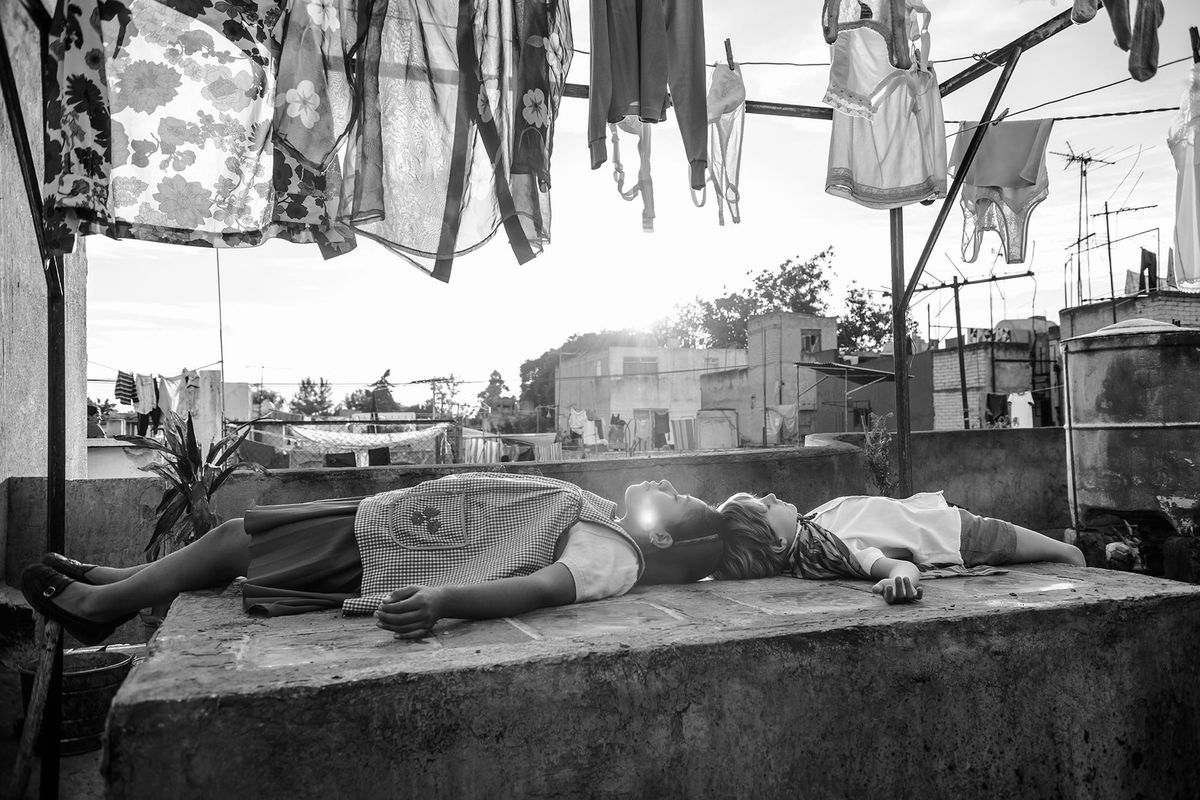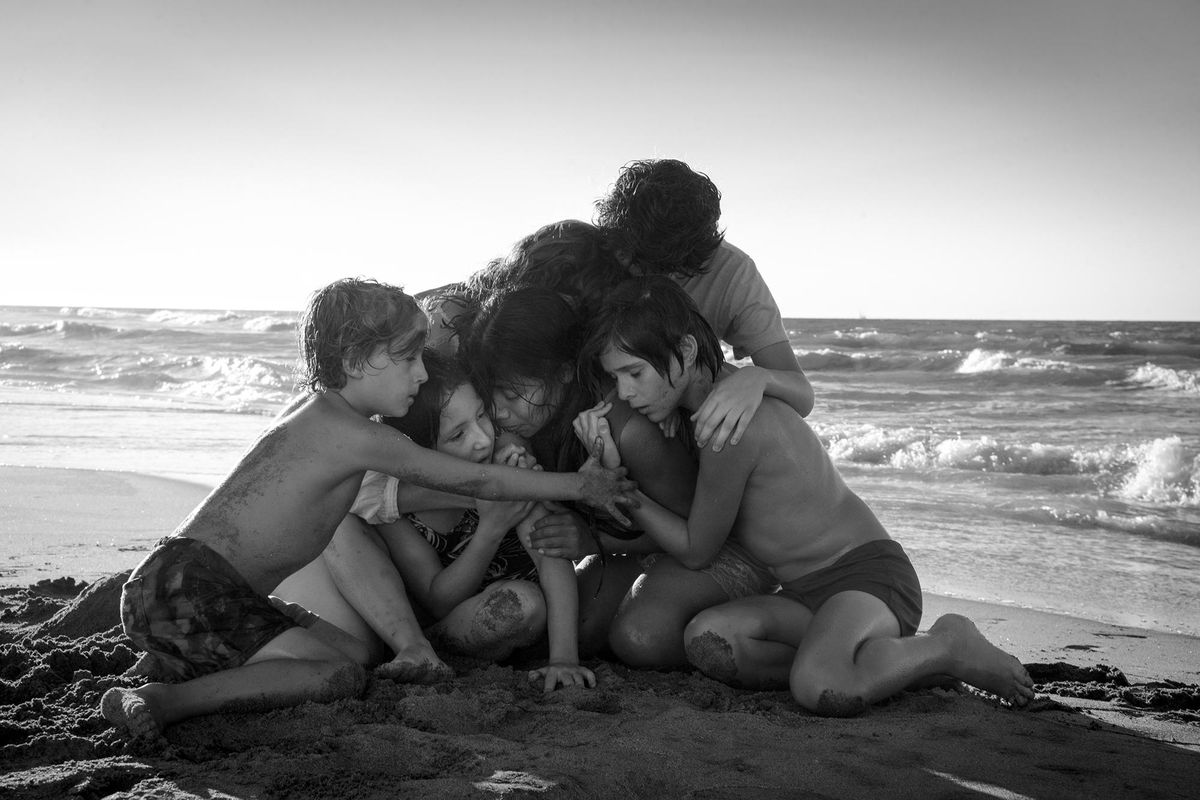Review: The movie ‘Roma’ isn’t as good as you’ve heard – it’s even better
Yalitza Aparicio, left, with Marco Graf in “Roma.” (Carlos Somonte / Netflix)
“Roma,” a masterful drama by Alfonso Cuaron, is many things at once: epic and intimate, mythic and mundane. Based on Cuaron’s memories of growing up in a bourgeois Mexico City household in the 1970s, this tone-poem to his youth is shot through with vivid sensory cues that pulse with equal parts delight, sensuality and sadness.
Shot by Cuaron himself in widescreen black-and-white – a format that lends monumentality and permanence to the quotidian, evanescent events depicted here – “Roma” achieves the rare feat of making the personal authentically political, not through explicit polemic or tortured metaphors, but simply by observing life with enough perspective to reflect it in all its contradictions. And reflection is the operative term in “Roma,” which takes its title from the middle-class neighborhood where Cuaron grew up.
Early in the film, the entire screen is taken up with a pailful of sudsy water as it sluices over a courtyard floor, its slick surface at one point capturing a balcony and a plane flying overhead. The person mopping the floor is Cleo (Yalitza Aparicio), who works in the household of Sofia and Antonio (Marina de Tavira and Fernando Grediaga), cooking, cleaning and caring for their four children. The initial scenes of “Roma” silently follow Cleo through the labors of her day, gradually establishing the rhythms of life, not as it’s so often dramatized or oversimplified, but as it is lived.
What becomes clear is that, although Cleo and her fellow domestic staff members are subservient to their bosses, the relationship isn’t limited to conventional “Upstairs Downstairs” dynamics of power and servitude: Cleo is clearly a member of a family that doesn’t just depend on her physical work, but on her emotional labor as well, putting their relationship with her into territory that exists somewhere between exploitation and genuine affection.
Cuaron, who based Cleo on his real-life nanny, might have thought twice about the pitfalls of a prosperous filmmaker making a tenderly nostalgic movie about the indigenous woman who nurtured him as a lad. On paper, the setup sounds unforgivably patronizing, the stuff either of cheap sentiment or clueless privilege. But “Roma” dodges those traps, building into something far more complex and emotionally shattering as Cuaron’s discreet, gracefully swaying camera follows Cleo through an initially uneventful, finally tumultuous period in her life.
One way that Cuaron avoids solipsism is to keep his own most consequential experiences to the story’s margins – his parents’ split is portrayed obliquely, through allusive moments and eavesdropped conversations. But the grievous impact of that event permeates the film, even as Cuaron’s camera accompanies Cleo to the movies with her friends, or on a shopping trip or at a hunting party at an aristocratic hacienda. A master of constructing environments that convey volumes of essential information about the people who move through them, Cuaron here deploys exquisite visual and aural details – sometimes seemingly random but always clearly resonant – to do the heavy lifting usually reserved for plot, dialogue and characterization.
He also operates the camera himself (marking a rare occasion when he isn’t collaborating with longtime cinematographer Emmanuel Lubezki), keeping it at a respectful middle distance from the action (the film contains surprisingly few close-ups) and moving it with the bravura energy for which he has become famous. But flourishes like tracking and deep-focus shots, as well as the expansive 65-millimeter canvas, aren’t just exercises in technique for technique’s sake. As the episodes of Cleo’s life pile up, it becomes clear that Cuaron is capturing the most salient elements of this time of his life, including the natural environment, architecture, history and the era’s convulsive politics. (Cuaron reportedly used his family’s old furniture to decorate the copy of his childhood home.)
Sometimes they’re in his peripheral vision; sometimes he puts them front and center, such as when his heroine finds herself caught in a student demonstration that turns dangerously violent. More often than not, he leaves them open to maybe-Marxist-maybe-not interpretation, such as when a forest fire ravages acreage belonging to wealthy landowners.
“Roma” possesses unforgettable sequences of terror and grief, as well as more than a few grace notes of humor, the latter mostly at the expense of the mother’s driving skills. Admirers of the director will see plenty of homages to the filmmakers who influenced him, from his Felliniesque staging of a group martial arts exercise and a critique of the leisure class (reminiscent of “Rules of the Game”) to a brief glimpse of the 1969 sci-fi adventure “Marooned,” which bears more than a little resemblance to his 2013 sci-fi adventure ”Gravity.“
But perhaps the most apt reference when describing “Roma” is to “War and Peace.” Like that novel, this is a film that pays homage to the moments of life rarely elevated to the status of high art, but whose life-or-death contours merit just that scale, scope and thoughtful attention. In a breathtakingly naturalistic, unforced performance, Aparicio – who was discovered in a rural village in Oaxaca – inhabits Cleo, with all of the suffering, love and dignity that she obviously warrants. What if, Cuaron asks, we invested individuals and moments usually ignored or relegated to invisibility with that same beauty and inherent worth?
With “Roma,” one of our finest filmmakers has delved into an experience uniquely his own to create something that feels simultaneously sui generis and universal, deeply private and instantly recognizable. That describes a great work of art, and that’s precisely what “Roma” is.

